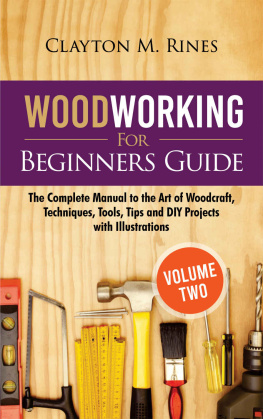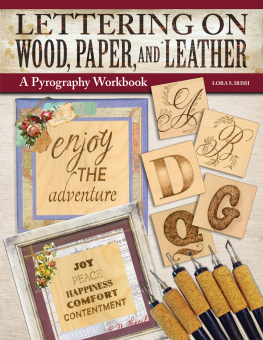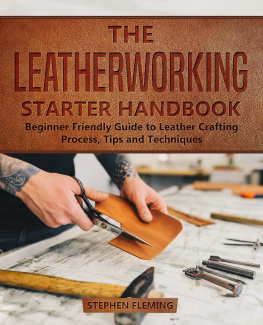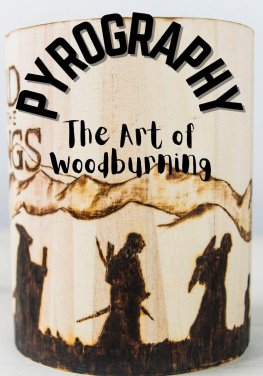A Beginner Friendly 3 in 1 Manual with Instructions on Wood Burning, Leatherworking and Wood working
Clayton M. Rines
Copyright 2020 Clayton M. Rines
The author retains all rights. No part of this document may be reproduced or transmitted in any form or by any means, electronic or mechanical, including photocopying, recording, or by any information storage and retrieval system without permission in writing from the author. The unauthorized reproduction or distribution of this unique work is illegal.
Introduction
The term pyrography has its origin in Greek, and it means pur graphos (fire writing), and it has been in existence since man discovered fire. Evidence of ancient men practicing this beautiful art can be found on the walls of caves and other structures. Writings, drawings, and other messages were inscribed and drawn on wood, walls, leathers, gourds, and other surfaces to pass messages, honor gods or to beautify the environment. Going back to the times of the ancient African men, the Egyptians, and in Asia, there are quite a lot of pyrography artifacts which points to the skills and ability shown by craftsman during those times. This art was commonly known as fire needle writing or drawing then. This process gave the artisans and avenue through which they got to showcase their skills and bring the most common objects to life.
With the discovery of fire came the art of pyrography, which employs the use of a heated sharp-pointed object to draw and write. A metal that is heated in fire is mostly used in the drawing of beautiful artworks and other designs. Wood burning is another term used to describe the art of pyrography in putting their skills into practice on a variety of surfaces.
Traditionally, pyrography was a form of art used in designing and decorating musical instruments and a variety of tools and items. Guitars, jewelry boxes, kitchen utensils, hairbrushes were etched with signature art to make the piece unique and to show it belongs to a particular individual. Nowadays, however, the technique has gone a step further in the evolutionary scheme of things by actually burning designs on surfaces that are blank and devoid of any embellishments to convey on such pieces artistic values.
The pyrography pens are a relatively recent invention that has given rise to more elegant pieces of equipment.
The primary tool used in drawing and writing in pyrography is a heated metal tool, but in this age and time, you can make use of a whole array of tips in discovering and giving your piece of work that distinct look to make it unique and stand out. There are pyrography tools that are quite similar to the soldering iron, which allows you to draw solid lines, and there are others that enable you to perfect fine fainted shaded lines. The amount of pressure that you apply to the surface with the drawing tool will also determine the tone that can be obtained.
The types of woods that are used in pyrography are usually light in color, e.g., sycamore, beech, and birch are excellent surfaces for drawing on due to the light grain and color. Your choice of wood will be determined by the outlook you have in mind for your finished work.
It is essential that no matter your choice of wood, it should not be treated, avoid particle boards or pressure-treated boards as such materials have undergone some form of chemical processing or the other. When you apply your pyrography tool to such a piece of wood, the chemicals in the material are set free. If you are not putting on protective gear, you will most likely inhale the toxic fumes. The fumes are not the only harmful substances that are released when you burn wood, resins, sawdust, and wood shavings can also cause serious health problems if you don't adequately protect yourself.
With your materials ready, safety check put in place; you can begin to pour your skill and fine art onto the piece of wood. Your design can either be transferred to the wood surface by making use of a graphite paper/tracing paper, or you can draw straight to the wood surface with a pencil. Once the image is on the wood surface, the burning can begin. The range of items that you can put your signature design is determined by the limit you put on your imagination.
To get started with wood burning, you will need to get a few basic supplies which include the following;
Wood burning pen
Pyrography machine
The wood sample on which you are going to burn
Sandpaper
The design you want to wood burn
Tape (masking paper)
Carbon paper/tracing paper/graphite paper
Knowing your tools
The wood-burning pen is a relatively easy to use tool for pyrography. It is shaped like your everyday pen, which comes with a metallic tip that heats up when the device is connected to a power source and switched on. Most wood-burning pens have temperature controls, which gives you the ability to lower or increase the temperature of the device depending on the type of art that you are working on at the moment. Taking an in-depth look at the pen, you will notice that it comes with a variety of tips to be used for different aspects of creating a piece of work. They can be used for shading, straight lines, rounded lines, curves, dots, etc. Most wood-burning machines are built in such a way that the pen does not sit directly on the bench; they come with a metal stand to ensure your safety and other implements that might be on the workbench.
To get started, there is a need for you to understand, know, get familiar with the wood-burning pen and other tools that you will be using during the process. For starters, pick up a piece of wood that can be used for practice, connect your wood-burning machine to a source of power, and switch it on and let it heat for a few minutes. You can then proceed to carry out a few test runs on the wood with the set of tips that can be fitted to the pen. After using a tip to draw and you want to change it, switch off the device and let it cool down properly before switching to the next tip, then heat it again before use.
During these practice sessions with you getting to familiarize yourself with the pen and burning on wood, ensure that you don't rush, hold onto your pen firmly and draw deliberately, slow, and steady on the wood. If you are in a hurry, there won't be proper burning that will make the artwork as desirable as it should be. Take your time and be steady as you embrace this new found love.
Here are a few essential tips to be kept close;
When wood-burning and there is more smoke than should be, there is the probability that the temperature of the pen is way too high, and this will impair the quality of the burn in addition to smoke inhalation, which can cause adverse health conditions if you are not adequately protected. To ensure that your burn is smooth and of high quality, turn down the heat of the pen to reduce considerably the amount of smoke generated.








